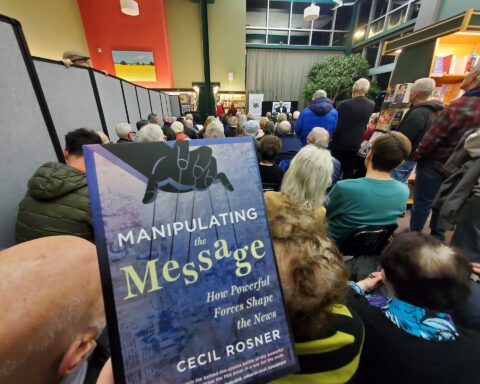The Charlie Hebdo massacre and subsequent hostage-taking and murders at the Paris kosher supermarket were supposedly in retaliation for the blasphemous manner in which the satirical publication portrayed Muhammad, the seventh century common era prophet of Islam.
Take #1: The true nature of satire
When satire first appeared in Western culture, it utilized good-natured humour to achieve its ends. Practitioners such as John Dryden believed that good satire nicked someone, as with a rapier. One did not conduct satire with the plunge of a broadsword. From what I have observed, the Charlie Hebdo practitioners often use a broadsword, not a rapier. Their depictions of Muslims – not to mention Jews and Christians – is hateful. It is often a blunt and not clever expression that borders on racism. Good satire was never intended in the first place to decimate one’s target. But, of course, satire today often eschews subtlety for crudeness.
Good satire was never intended in the first place to decimate one’s target.
Take #2: Blasphemy?
Blasphemy, they say. These very same people who call aloud the Almighty’s name (“Allah-u-akbar”) while mercilessly executing others? The Charlie killers called out the Almighty’s name in the street as they randomly executed a French gendarme, a co-religionist – a Muslim. They targeted and killed innocent Jews as they engaged in carefree shopping for Shabbat; tell me that isn’t a blasphemy that deeply offends the Almighty.
Blasphemy? The ISIS killers who chanted the Almighty’s name while slowly sawing off the head of Daniel Pearl? The bomb-jacket Palestinian blowing up a restaurant filled with non-combatants in Jerusalem? The 9/11 hijackers as they flew planes into buildings and randomly extinguished thousands of innocent lives?
All of them calling out Allah’s name, as if the Almighty blesses their vile acts. Now you tell me: which is the real blasphemy? Some sophomoric cartoon or someone who kills the innocent while imagining he has God’s blessing? Blasphemy indeed.
Take #3: A likeness of Muhammad?
I think that image on the cover of the latest Charlie Hebdo looks more like seventh century merchant Ali bin Jiddah than it does Muhammad. I jest. I say this to make the point that it is ludicrous to get upset over some racialized drawing of a random Arab likeness and to allow the ignorant cartoonist to tell you that it is a likeness of the beloved Prophet of Islam. Would people be as upset if the cartoonist had drawn a face on a banana and declared it to be the prophet’s likeness? I think not.
Take #4: Fanaticism
Quit with the manufactured anger, people of Islam. The anger over some poorly drawn image – like the random anger every time there is a rumour that some non-believer has burned or defaced a Qur’an is pointless. Stampeding crowds of hysterical men only serves the anti-Islamic narrative that all Muslims are raging fanatics.
Take #5: Canada responds
Back when people around the world were indeed going crazy over the so-called Danish cartoons and stomping and burning flags, Canada’s Muslim community was largely a model of decorum and sang-froid. The response here was “more in sadness than in anger.” That’s how you respond to being offended.
Take #6: Legitimate Responses
Here in democratic societies, we have a number of legitimate methods for responding to a medium that offends us – none of which involve violence.
- Write a letter to the editor
- Don’t buy the publication
- Boycott the advertisers and vendors
- Protest peacefully at the offending publisher’s location
- Publish an electronic or hard copy medium that presents an opposing point of view
- Invite the offenders to a public debate
- If you are truly religious, leave the extraction of vengeance to the Almighty.
See? No violence.
Here in democratic societies, we have a number of legitimate methods for responding to a medium that offends us – none of which involve violence.
Take #7: Media responsibility
Even though we have access to it, none of us in the mainstream media present the images of Daniel Pearl or others being beheaded. Why? Good taste – something I believe is in short supply at Charlie Hebdo. In many jurisdictions, I could easily publish such images, alongside images of women being raped and babies being slaughtered. I could print full page images of physically challenged people with an insulting caption about their condition but my conscience and public standards of morality will not allow me to do so.
In other words, not everything publishable should be published. I don’t believe that is for the government to determine, but in an educated society we trust that the publisher/producer and the public will arrive at that destination of good taste and editorial judgment.
Take #8: A senseless death
The staffers at Charlie Hebdo were murdered for some poorly drawn offensive cartoons (a few of which remind me of the Nazi-era caricatures of hooked-nosed Jews). They didn’t die for revealing a government or corporate cover up or for opposing a corrupt government policy or defending the downtrodden. I repeat: they died for some poorly drawn, not-very-funny cartoons. This is not Pulitzer Prize stuff, not a Daniel Pearl or Zahra Kazemi death. Yes, their murders offend us and violate our sensibility about freedom and innocence. Yes, they have died for freedom of expression. But to me, dying for some mean-spirited cartoons seems a terrible waste.
Take #9: When two bullies collide
Part of me believes that the rest of us have been caught in a fight between two bullies. The first bully yells offensive taunts and draws offensive images. The second bully overreacts and brings guns to the schoolyard knife fight, so to speak. On both sides there have been bullying, taunting behaviour; though, in magnitude, they are incomparable.
Richard M. Landau has been responsible for adjudicating disputes and enforcing a television network code of ethics in a religious broadcasting setting since 1992. He is a graduate of Carleton University and the University of Ottawa. A leader in interfaith dialogue, Landau has consulted with the UK Home Office, and the White House Office of Community- and Faith-Based Initiatives. He works closely with leadership in all of the major world religions. He is author of “What the World Needs to Know about Interfaith Dialogue.”





